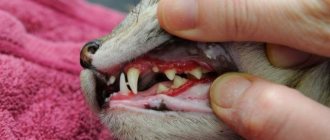Skin diseases are a common occurrence in domestic and farm animals. Pathologies manifest themselves in different ways: hair loss due to attack by parasites, problems with the epidermis and internal disorders. The causes of these symptoms need to be accurately determined. The veterinarian will not only identify the disease, but also prescribe the correct treatment. Some skin diseases can be dangerous to your pet's health.
Causes of itching in the head and neck area in cats
Cats scratch their necks until they hurt for a variety of reasons. This behavior is provoked by external factors, ectoparasites and a number of diseases of varying degrees of danger. The largest number of cases are due to allergies and insect parasites. A smaller percentage of the probability is associated with viral, autoimmune and other diseases.
Ectoparasitosis
Otodectes cynotis, or ear scabies, is caused by mites. They settle in the ears or ear canal and cause severe itching in the cat. As a result, she regularly shakes her head and scratches her ears until they hurt. It is transmitted by contact and affects mainly young animals.
Notoedrosis or pruritic scabies develops against the background of Notoedres cati tick bites. The disease is characterized by inflammation of the scalp, hair loss and severe itching. An infected cat constantly scratches its head until sores appear.
Important! Notoedres cati itches spread from cats to other animals and even humans. For some time they cause pseudo-scabies and then go away, since there are no favorable conditions for life.
Cheyletiellosis, or wandering scabies, is caused by Cheyletiella mites. The fact that a cat has these parasites is indicated by severe itching and fine dandruff. The disease often spreads to humans and causes an itchy rash.
Demodectic mange or ironworm is the result of exposure to mites of the genus Demodex. They develop their vital activity in the sebaceous glands and hair follicles. As a result, bald patches of skin and sores appear on the cats’ faces. The areas most commonly affected are the areas around the eyes and mouth, as well as the front legs.
Fleas are a common cause of scratching on the neck and other parts of the body. They parasitize primarily on cats and dogs. They can also temporarily transfer to humans. When infected with them, a large number of black crumbs appear under the fur of pets. These flea droppings are especially noticeable in the lumbar and back areas.
The animals themselves itch very much to the point of soreness, as they experience severe itching at the bite sites.
Allergies
A common reason why a cat scratches itself until it hurts is allergies. It implies an abnormal reaction of the body to a stimulus. When first hit, protective cells create an antidote and “remember” the allergen. And if it penetrates again, a violent reaction occurs in the body. It leads to inflammation, itching and other symptoms.
Allergies cause several diseases in cats:
- atopic dermatitis;
- flea dermatitis;
- food allergies;
- contact dermatitis.
Flea dermatitis
Flea dermatitis is a common reason why a cat scratches itself until it hurts. When one flea bites, it releases a special anticoagulant into the cat's skin. This substance prevents blood clotting. The pet becomes sensitized to it. And the body reacts to the bites of other fleas in the form of inflammatory processes, rashes and papules.
The affected areas are very itchy. The cat begins to behave restlessly and reacts nervously to touch. This type of dermatitis occurs in two forms: chronic and latent. In the first case, alopecia (foci of baldness) and nodules with flea feces develop on the body. The second is characterized by the appearance of papules with a red rim.
The cat begins to tear them apart until they hurt. Often secondary infection is associated with wounds.
Atopic dermatitis
The disease is typical for young animals aged 1 to 3 years. The main reason for its appearance is the uncontrolled selection of cats. As a result, animals develop allergies to dust and pollen. In this case, it is almost impossible to identify the allergen.
Important! Atopic dermatitis has no cure; cats will regularly scratch their skin until it hurts. The action of therapy is aimed at suppressing symptoms.
Dermatitis in cats manifests itself with the following symptoms:
- the appearance of dandruff on the withers and back;
- hair loss;
- labored breathing;
- discharge from the eyes and nose;
- cough;
- profuse salivation.
Contact dermatitis
This allergy is similar in symptoms to atopic dermatitis. It often manifests itself when the pet comes into contact with household chemicals, toilet filler, the hair of other animals, and flea products. Contact allergies are manifested by severe itching, flaking of the skin and a small rash. Often a cat itches until it hurts. And this increases the risk of secondary infections.
Food allergies
Allergens can accumulate in the body of animals. With their regular consumption, health problems begin. Food allergies are characterized by:
- the appearance of a rash on the cat’s neck and head;
- hair loss;
- the appearance of dandruff;
- inflammation of the eyelids;
- unpleasant odor from the mouth.
Important! Symptoms of food allergies in cats are often accompanied by vomiting and indigestion.
A common cause of food allergies is feeding cats salted, fried, smoked and other prohibited foods from the table. Mixed feeding with industrial feed and natural products also contributes to its appearance.
Ectoparasites
Human flea dermatitis
Most often, cats suffer from flea attacks. The saliva of blood-sucking insects causes an allergic response characterized by itching. The pet scratches the affected area and flea dermatitis develops.
Microorganisms - permanent inhabitants of the skin - join. The inflammatory process develops according to the scheme described above. Skin parasites - Heyletiella mites feed on the epidermis, causing itching and scratching. Ectoparasites pose a danger to humans. Adult fleas attack people and bite painfully. The larvae crawl from the litter to open areas and feed on the epidermis.
But the greatest harm to humans is caused not by the insects themselves, but by the pathogens of the following diseases, transmitted by all phases of arthropod development:
- brucellosis;
- anthrax;
- typhus;
- helminths;
- tick-borne encephalitis.
Cheyletiella are not so harmful, however, children or old people develop itching after contact with a pet. Ticks cannot stay on cold, hairless human skin for long. If you interrupt contact with your pet, the itching disappears. When restarted it appears again.
Although the biology of parasites is different, the measures to combat them are the same. Adult arthropods and larvae are destroyed with an insectoacaricidal spray. After 8-10 days the treatment is repeated.
Drops of Stronghold
Eggs are immune to poisons. After 8-10 days, the larvae hatch from them, so you need to destroy them before they become sexually mature. External anti-inflammatory wound healing agents are applied to the damaged surface. To speed up healing, pets are switched to veterinary food for cats with skin diseases.
Prevention consists of regular use of Spot-on drops, which protect against ectoparasites and worms.
Skin infections
Scratched cat sores on the neck and head in some cases occur due to infectious diseases. Cats with access to the outdoors are especially susceptible to them. When a bacterial infection of the skin occurs, one of two forms develops:
- Dry. Dry crusts, dandruff and scabs form on your cat's neck.
- Wet. It is characterized by the appearance of blisters and ulcers with liquid contents inside.
Animals with sensitive skin are predisposed to eczema. It develops through prolonged contact with flea collars, harnesses, after insect bites and skin parasites.
Important! Diabetes mellitus, neuropathy and hormonal changes contribute to the appearance of eczema.
A rash and blisters appear on the pet's body. Severe itching leads to the cat scratching its neck until it bleeds, and sores appear that do not go away for a long time. To eliminate eczema, antibacterial therapy, various ointments and powders are prescribed.
Viral dermatoses
Cat scratching on the skin is also characteristic of viral dermatoses. The herpes virus affects the eyes and respiratory tract of the animal, often manifesting itself as skin lesions. They are often localized in the area of the nose and eyes, less often on the paws and stomach.
Feline herpes is characterized by:
- bloody stains;
- small rash;
- swelling of the skin;
- small scabs on the neck, sores on the head.
Skin changes appear 1.5 weeks after the disappearance of conjunctivitis and other characteristic symptoms.
Cowpox or poxvirus is a rare disease. It can enter the cat's body through the bites of small rodents. It manifests itself as skin lesions in the form of nodules and small ulcers. With good immunity, it goes away on its own. In weakened animals there is a risk of developing a severe form.
Autoimmune dermatoses
Autoimmune diseases are characterized by an abnormal reaction of the immune system to its own tissues and cells. Skin manifestations on the body of cats are characteristic of several diseases:
- Common pemphigus. It is characterized by the development of ulcers in cats around the mouth and in its cavity itself. Involves long and difficult treatment. It often ends critically for animals.
- Erythematous pemphigus. Crusts, ulcers, blisters, sores and other lesions are concentrated in the area of the animal’s nose and bridge of the nose. Sometimes the disease is accompanied by a change in skin color.
- Pemphigus foliaceus. The main symptom is the appearance of large pustules on the skin near the mouth and ears. Associated signs in cats include elevated body temperature, refusal to eat, and apathy.
- Systemic lupus erythematosus. It affects all systems and organs of the animal. Wounds on the scalp manifest themselves through depigmentation of the skin, the development of a rash and the subsequent formation of ulcers.
Lichen
Ringworm is a disease in which the skin becomes covered with an itchy rash, hair falls out, and crusts form.
The following types of lichen, characterized by the appearance of crusts on the back, are common to cats and people:
- Shearer.
- Pink.
- Red flat.
Ringworm
Ringworm
The disease is caused by micromycetes Microsporum and, less commonly, Trichophyton. Initially, single patches of baldness appear, which gradually grow and cover the entire body. The skin peels off, breaks down, ichor leaks out, and crusts form. Kittens and pets with weakened immune systems get sick. Veterinary care will be required to eliminate pathological signs.
External wound healing ointments and gels are used. For large-scale lesions, Imaverol is effective. Treatment consists of bathing the animal four times at three-day intervals.
Imaverol
To speed up recovery, medicated food is used for cats with skin diseases. Prevention consists of complying with standards for keeping and feeding professional food of at least premium class. Vaccines against fungal diseases have been developed, however, felinologists do not risk using them due to frequent complications.
Pityriasis rosea
The causative agent of the disease is a virus. The disease is inherited. Pink itchy spots cover the entire body. The pathogenesis is the same as for ringworm. Pathological symptoms occur when the immune system is weakened. Children, the elderly, and people with immunodeficiency are isolated from a sick cat.
Treatment is prescribed by a veterinarian. They use antihistamines, external agents, and immunostimulants. Exclude natural food and dry food. Use wet medicinal canned food. The duration of therapy is determined by the veterinarian.
Be sure to read:
Why does a cat constantly scratch its chin: what kind of disease is it?
Skin tumors
Skin neoplasms are in first place among oncological diseases in animals. By their nature, they are also divided into benign and malignant forms.
The first includes:
- Basalioma. The sore is a pigmented dome-shaped tumor. At the point where it appears, the animal loses its hair.
- Cutaneous histiocytoma. Characterized by a rapidly growing tumor under the skin. A rare pathology for cats.
Malignant skin tumors develop in two cases:
- Squamous cell carcinoma. The disease manifests itself in the nose, eyelids and ears. Metastases spread through the lymphatic system.
- Basal cell carcinoma. Develops from basal cells of the skin. Characterized by rapid growth and a high probability of metastasis.
Preventive actions
The complex of preventive measures to prevent skin diseases in cats must include:
- Regular visits to the veterinarian.
- Timely treatment with antiparasitic and anthelmintic drugs. Using flea collars.
- Food quality control. It is unacceptable to feed your cat economy class food.
- Maintaining hygiene in areas where animals are kept. Your cat's bowl and litter box should be kept clean.
If your pet has at least one of the signs of a skin pathology, it should be shown to a doctor immediately.
History taking
Diagnostics will help you understand why your cat scratches its neck and what caused the sores. But before carrying it out, the veterinarian needs to collect an anamnesis.
Age and breed
A kitten up to one year old is susceptible to skin and subcutaneous parasites. Young animals suffer predominantly from allergic reactions. If an elderly cat scratches its neck until it bleeds and hurts, this may be due to autoimmune dermatoses.
The breed of the animal also leaves its mark. Persian cats are prone to dermatophytosis and dermatitis, while Sphynx cats are prone to allergies and neoplasms.
Lifestyle
A large number of animals in one area, access to the street, participation in cat shows and other factors increase the risk of infection with parasites and viral diseases.
Seasonality
Allergies to pollen, bee or mosquito bites have a pronounced seasonality. Flea dermatitis in cats manifests itself regardless of the time of year. But it is most common in August-September.
Eczema
Weeping eczema
Eczema is a skin disease of the deep and superficial layers. There are dry (chronic) and weeping (acute) forms. In both cases, the purulent exudate dries out and forms crusts.
There are the following causes for the development of eczema:
- Traumatic . Occurs as a result of damage from accessories that rub the skin, burns, frostbite, and arthropod bites. It occurs in a wet form, and after eliminating the causes of the disease, rapid recovery occurs.
- Neuropathic eczema. A congenital anomaly characterized by bilateral dermatitis. It worsens under the influence of stress factors. It is incurable and requires lifelong use of symptomatic medications.
- Reflex eczema. Occurs under the influence of allergens in the saliva of arthropods and contact irritants. Symptoms, treatment and prevention are described above.
- Internal factors. The skin reacts to pathological signals coming from affected internal organs. Clinical manifestations disappear when the underlying disease is eliminated. To speed up recovery, wound-healing external agents and medicated food are used for cats with skin diseases.
Diagnostic methods
Diagnostics will help determine why a cat scratches its neck until it hurts. The doctor prescribes one or more methods:
- Combing wool. A fine comb is used for this. The procedure allows you to see fleas, lice and skin mites on cats. Can be done independently at home.
- Trichogramma. Determines the presence of spores and eggs on the hair shaft.
- Examination of earwax under a microscope. It is carried out if otodectosis is suspected.
- Wood's lamp. Shows the glow of spores on the skin of an animal from certain types of fungus.
- Cytological examination. The veterinarian recommends this to detect yeast and bacterial infections.
- Allergy test. Prescribed for confirmed atopic allergies in cats.
- Skin scraping. Detects ticks, their larvae, and spores.
- Elimination diet. Prescribed by a veterinarian to determine the allergen for food allergies.
- Fungal culture. An effective method for dermatophytes.
What actions should I take?
Sores on the back along the cat’s spine (as well as in other places) cannot be ignored. The animal needs help. It all depends on the reason.
If the owner is sure that the cat is being attacked by parasites, and the sores are caused precisely by their bites, the animal should be treated for fleas. Today there are enough products on sale that will help quickly solve the problem. The wounds themselves can be treated with an antiseptic to prevent infection and speed up the healing process.
If you suspect that skin problems are the result of an allergy, you can try to review your pet's diet. However, it is not always possible to guess which product caused the reaction, and time passes, and the cat needs to be treated. Therefore, it is better not to take risks, but to immediately show the animal to a veterinarian. He will take tests, determine the irritant and tell you how to deal with the cause of the sore.
This also applies to other situations where the lesion on the back is similar to lichen or demodicosis. You should not engage in amateur activities. Professional diagnosis is required, and then serious treatment . It often involves taking antifungal, anti-inflammatory, and antibacterial drugs.
Only competent advice from a specialist, complex therapy and the caring hands of the owner can quickly alleviate the cat’s condition and eliminate sores without consequences.
General treatment tips
You cannot select medications and dosages on your own. The choice should be made by a veterinarian, taking into account the diagnosis and individual characteristics of the cat. Before contacting a veterinarian, Miramistin is allowed to be used. This broad-spectrum drug rarely causes unwanted reactions or complications.
Be sure to complete the course of treatment to the end. If you stop using medications at the first improvement, the disease may recur and become chronic . It will be necessary to take more aggressive medications to cure the cat, both to alleviate the symptoms and to eliminate the cause of the disease.
You cannot refuse treatment. Since the sores cause severe discomfort to the cat, she can scratch them, violating the integrity of the skin. This increases the risk of infection entering the wounds. Purulent complications are possible.
During treatment, medications should not be given without the permission of the veterinarian. Before giving your cat any drug, including dewormers, you need to check its compatibility with the medications used for treatment.
A sick animal should also not be vaccinated: due to a weakened immune system, the reaction can be unpredictable and complications are possible.
Many pathologies are transmitted to people, so owners should follow safety rules when treating a cat so as not to become infected. In some cases, the veterinarian recommends preventative treatment for family members. Do not neglect such recommendations. There is no need to walk a sick cat, as it can easily infect other animals. The risk of complications will also increase on the street.
External symptoms: cat behavior
To make a correct diagnosis, you need to observe changes in the pet's behavior. Cats may become restless and irritable if they suffer from ticks and insects.
Infectious pathologies often cause lethargy and apathy, refusal to eat, and play with their owners. In addition, most often sores cause physical discomfort to the pet, which leads to the need to scratch or intensively lick the affected area.
We invite you to watch this video:











